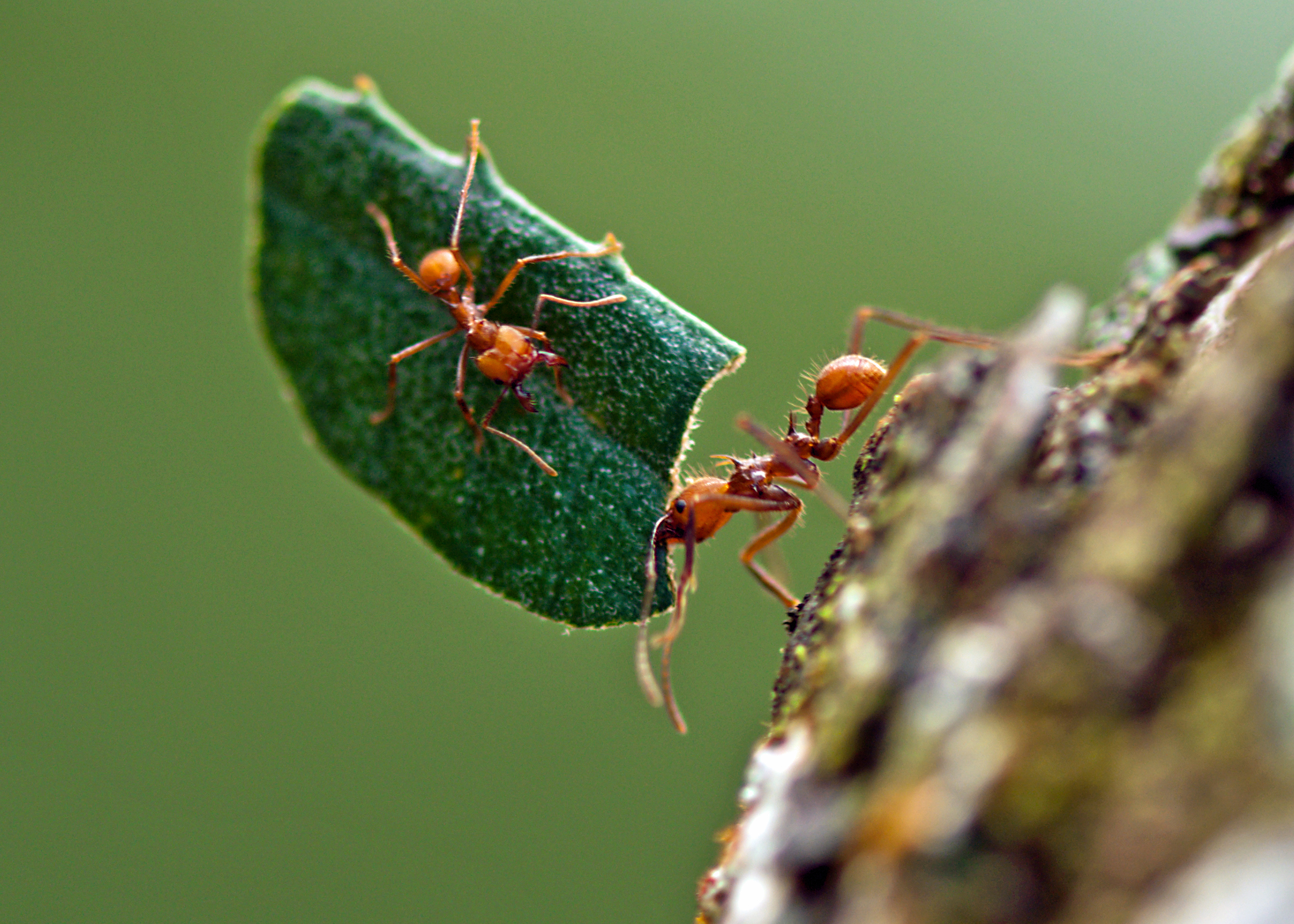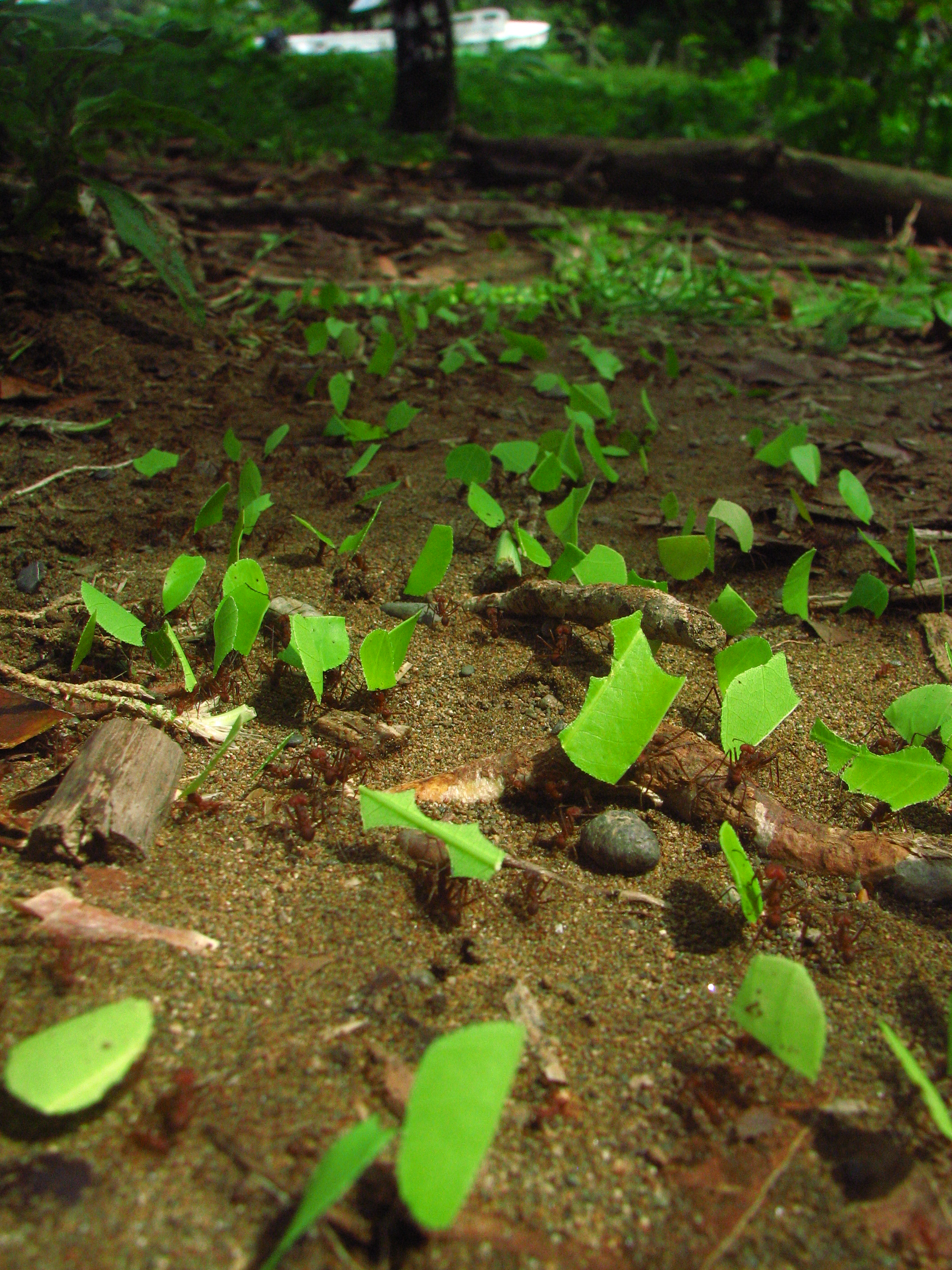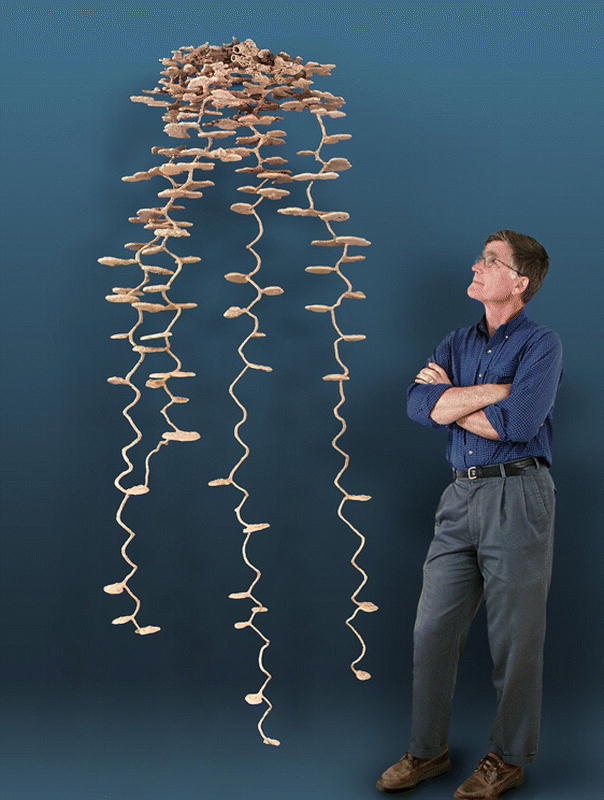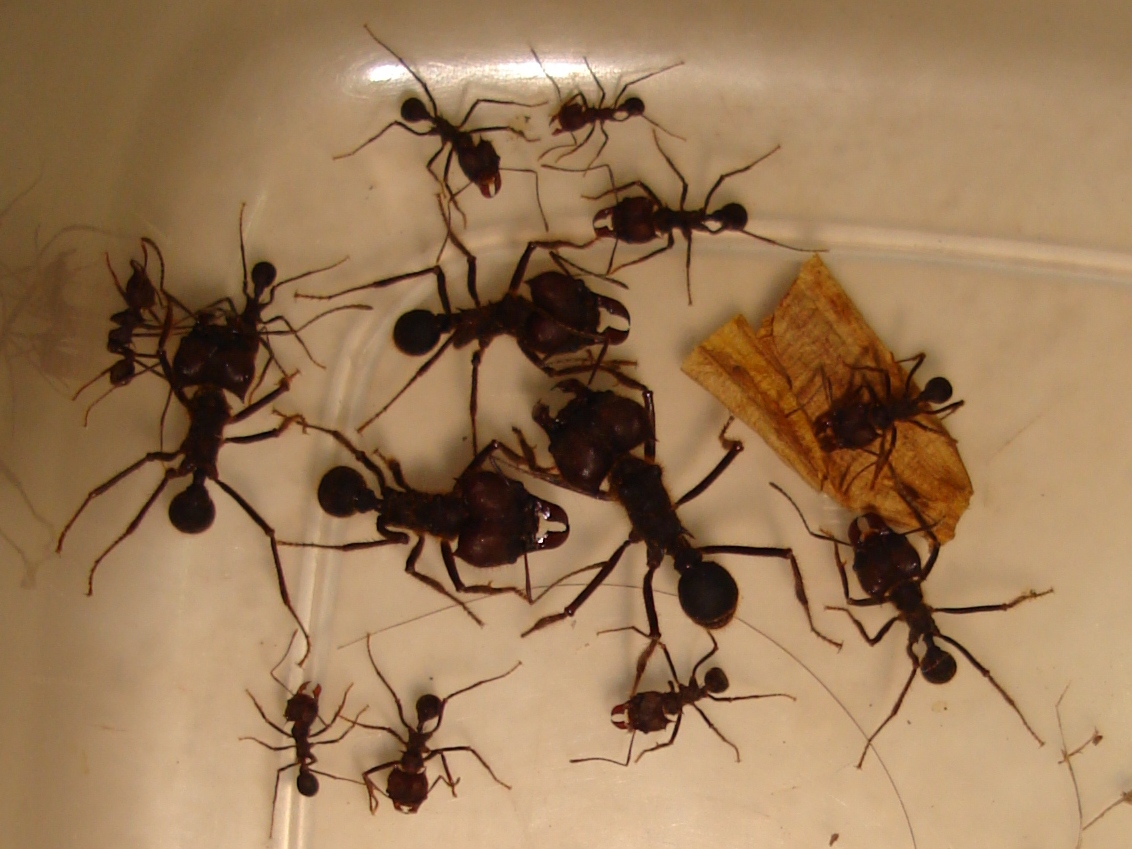
Credit: Kathy and Sam from Beaverton, Oregon, via Wikimedia Commons
There are only four creatures on Earth that tend crops: humans, weevils, termites and, most successfully of all, ants.
Around 10,000 years ago, humans switched from being nomadic hunter-gatherers to sedentary farmers. The food surplus allowed us to develop civilization.
But ants beat us to it, becoming “civilized” 60 million years before then.
Scientists think it may have been after the Chicxulub asteroid, when darkened skies meant fewer plants, that ants began to rely on fungus.
Soon after, leaf cutter ants began to grow their own fungus, gathering organic material and bringing it into their nests to feed their crops.
And soon after that, they became codependent. Leaf cutters could only eat their specially grown fungus. And the fungus could only survive when dutifully tended by the ants.
To accomplish this, the ant colony evolved into classes. Large foragers cut and gather the leaves. Smaller gardeners chew them into the mash that feeds the fungus.
Still smaller ants tend the fungus and spread natural antibiotics, from pits on their exoskeletons, to control parasitic bacteria that live on the fungus.
Thriving this way, a single colony can contain millions of ants, tending hundreds of chambers, dozens of feet deep into the ground.
Lessons in cooperation that perhaps our human communities could learn from. Though very few of us would want to live on fungus alone.
Background
Synopsis: Only four types of animals on Earth tend crops: ants, termites, weevils and humans. While humans began cultivating crops about 12,000 years ago, some ant species have been farming gardens of fungi for more than 60 million years. When pathogens threatened their crops more than 15 million years ago, leafcutter ants formed an alliance with antimicrobial producing bacteria to protect their mycological crops—the original pest management program. Humans first used antibiotics from the same type of bacteria for medicinal purposes in 1890. Leafcutter ants, their fungal crops and their antimicrobial bacteria are inextricably interdependent.
- Humans aren’t the only farmers on Earth; three types of insects have been farming for millions of years: ants, termites and weevils.
- Humans switched from nomadic hunter-gatherer lifestyles to permanent settlements and farming around 10,000 BC during the Neolithic Revolution, ultimately enabling the development of human civilization. As Neolithic humans cultivated grains in the eastern Mediterranean region to feed entire communities, wild plants were transformed into domesticated crops that depended on human husbandry for survival.
- Some species of termites began farming fungus about 25 to 30 million years ago. Their well-tended fossil fungal gardens have been unearthed in Tanzania.
- Certain beetles known as weevils first farmed fungi more than 86 million years ago in tunnels bored into trees, making them Earth’s first farmers—while dinosaurs still roamed Earth.
- However, a case can be made that Earth’s most sophisticated insect farmers are fungus-farming attine ants. Their advanced social organization has allowed them to improve agricultural practices in their subterranean mycological gardens for as much as 66 million years, including domestication of their fungi and protection of their crops using antibiotic pathogen management for around 15 million years, while avoiding the effects of antibiotic resistance.
- Ants evolved more than 140 million years ago and are one of Earth’s most successful organisms with more than 12,000 species.
- A recent census counted about 20 quadrillion (20,000,000,000,000,000) ants on Earth. That’s 2.5 million ants for every human on Earth, enough to wrap the equator eight million times with a single chain of the tiny creatures. It is almost certainly an undercount since subterranean ants are difficult to count.
- The total biomass of ants is more than all wild birds and mammals combined and is more concentrated in tropical forests and shrublands.
- Ants have developed sophisticated social structures that allow colonies to act as a single superorganism, enabling their remarkable success.
- Different species of ants are characterized by their distinctive adaptations.
- Carpenter ants shred wood to make their nests.
- Aggressive fire ants inject venom into their victims.
- Docile, hardworking leafcutter attine ants harvest fresh leaves to fertilize their gardens of fungi—the subjects of this episode.
- In early Cenozoic tropical rainforests of South America, the ancestors of attine ants developed a taste for fungus and began cultivating it in garden chambers within their underground nests.
- This shift occurred soon after the Chicxulub impact, so some scientists postulate that darkened skies limited photosynthetic food sources while abundant decaying organic matter may have fueled a fungal boom that the ants were able to exploit.
- The spongy “mold” you may have seen on bread is made of thin filaments that are the vegetative part of a fungus called the mycelium. Mushrooms are the fruiting bodies of fungi that produce spores that will generate more mycelium.
- By 25 million years ago, possibly in response to a cooling climate, attine ants had emerged from the rainforest and domesticated a single type of fungus that produced fruitlike balls along its filaments, the favorite food of these ants. They fertilized their crop with organic litter from the forest floor but also ate other foods.
- About 15 million years ago, some of the attine ants specialized even further, with cultivation practices that drove the development of “obligate mutualism” between the ants and the fungus—both species became completely dependent on each other.
- These “higher attines” are the leafcutter ants that coevolved even further with the fungus, protectively sequestering it in their meticulously clean underground farms and feeding it highly nutritious freshly cut leaf fragments.
- Higher attine ants are native to the Western Hemisphere and have been found as far north as New Jersey and as far south as the Patagonian desert of Argentina.

Leafcutter ants transporting leaves to their nest to feed their fungus farm.
Credit: Bandwagonman at English Wikipedia, via Wikimedia Commons - Leafcutter ants can’t eat their cargo. They have evolved to depend upon the fungus to digest plant matter for them. These ants have lost the ability to produce an amino acid called arginine. Without the fungus to eat, they would starve.
- The fungus was reproductively isolated for millions of years while being propagated by the ants in their subterranean farms, so it lost the ability to produce mushrooms or spores. Without the ants to help it reproduce, the fungus would soon die out.
- The ants can’t live without the fungus, and the fungus can’t live without the ants.
- It’s a big gamble—each massive leafcutter ant colony grows a single strain of fungus—a mycelium monoculture that makes the entire colony vulnerable to pathogens.
- Most fungal ancestors don’t exist in the wild anymore, so if their crop becomes infected and dies, the whole leafcutter colony will perish unless the ants can acquire a piece of a similar fungal strain from a neighboring colony.
- Soon after leafcutter ants domesticated their fungus, scientists believe a parasitic microfungus called Escovopsis evolved to infect and live off of their farms.
- So, about 15 million years ago, the ants evolved another vital symbiotic relationship, this time with a strain of actinobacteria that produces antimicrobial secretions. Mature leafcutter worker ants evolved to have pits and pockets in their exoskeletons to nurture and protect the bacteria.
- Amber from the Dominican Republic that is more than 15 million years old contains ants with these bacteria clinging to their exoskeleton pockets. It is the same type of bacteria that humans began to use around 1890 to source antibiotics for medicine.
- While the parasitic microfungus Escovopsis still feeds on their food source, it rarely takes over because the ants patrol their gardens and target intruding pathogens with pinpoint precision.
- Leafcutter ant colonies can be dozens of feet deep with thousands of chambers and as many as seven million ants, each with their specific role within the complex social structure of the nest. It takes a village to farm enough fungus to feed their huge colonies!

The nest architecture of the Florida harvester ant. Cousins of fungus-farming ants, these ants store seeds in “granaries” in their chambered nests. Attine fungal garden chambers may be arranged similarly.
Credit: Shaners Becker from Seattle, via Wikimedia Commons- Before a higher attine virgin queen takes to the sky to mate, she takes a blob of the old colony’s fungus in her mouth to start her new colony. After mating she finds a worthwhile burrow, sheds her wings, and spits out her fungal blob that begins to grow. She lays her eggs on the blob for her larvae to eat, and when they grow into workers, they help the queen to tend the garden. She can lay eggs for 10 years after mating.
- Once a colony is about three years old, the ants diverge into different types of workers.

Different sizes of Atta insularis workers demonstrating the size variation of worker ants with different jobs in mature colonies.
Credit: Ramiro Chaves, via Wikimedia Commons - Large forager ants use their strong jaws to clip plant matter and transport it to the nest. These ants may be two to three times the size of other worker ants.
- At the nest, gardener worker ants clean the clippings and cut them into smaller pieces, then mix the pieces with their excrement, chewing it to create a mash that is formed into an irregular spongy ball-shaped mass. They propagate cuttings of fungal filaments by planting them in the mass. The growing fungus serves as the colony’s stomach, digesting leaf cuttings the ants can’t digest themselves.
- The tiniest ants with heads less than 1 mm in diameter care for the fine filaments of the fungus.

A colony of Atta laevigata leafcutter ants and their mutualistic fungus live in captivity at the Museum of Zoology of the University of São Paulo, Brazil.
Credit: Alex Wild, public domain, via Wikimedia Commons - Slightly larger ants continuously replenish the top of the fungal matrix with mash, patrol the gardens for debris and pathogens, apply antibiotic as needed, and remove spent matrix from the bottom of the mass as waste.
- Brood care worker ants move the queen’s eggs among the fungal gardens and watch over the larvae that hatch.
- Interdependence among leafcutter ants, their fungal crops and their antimicrobial bacteria has succeeded for millions of years.
- How have ants managed to prevent antibiotic resistance in their gardens for millions of years when humans struggle with the challenge after 133 years?
- Scientists are working to understand agricultural strategies used by these sophisticated farmers. What can human farmers learn from millions of years of ant farming experience? Here are a few examples of how leafcutter ants approach agriculture:
- Leafcutter ants groom themselves and each other to remove potential pathogens before entering their meticulously clean gardens.
- They build multichambered nests with complex tunnels to isolate their many gardens, sealing off any that might become infected.
- When they transplant their crops, they take along the substrate, including its microbiome.
- Ants monitor their crops constantly so they can target and treat problems early—humans call this precision agriculture.
- Ants use antifungal secretions from their symbiotic bacteria along with antimicrobial compounds from their saliva, including formic acid, hydrogen peroxide and peptides to defend their gardens against microbial pests.
- Leafcutter ants remove any contaminated or diseased portions of their garden and deposit them outside of their nest to prevent contamination of the colony.

